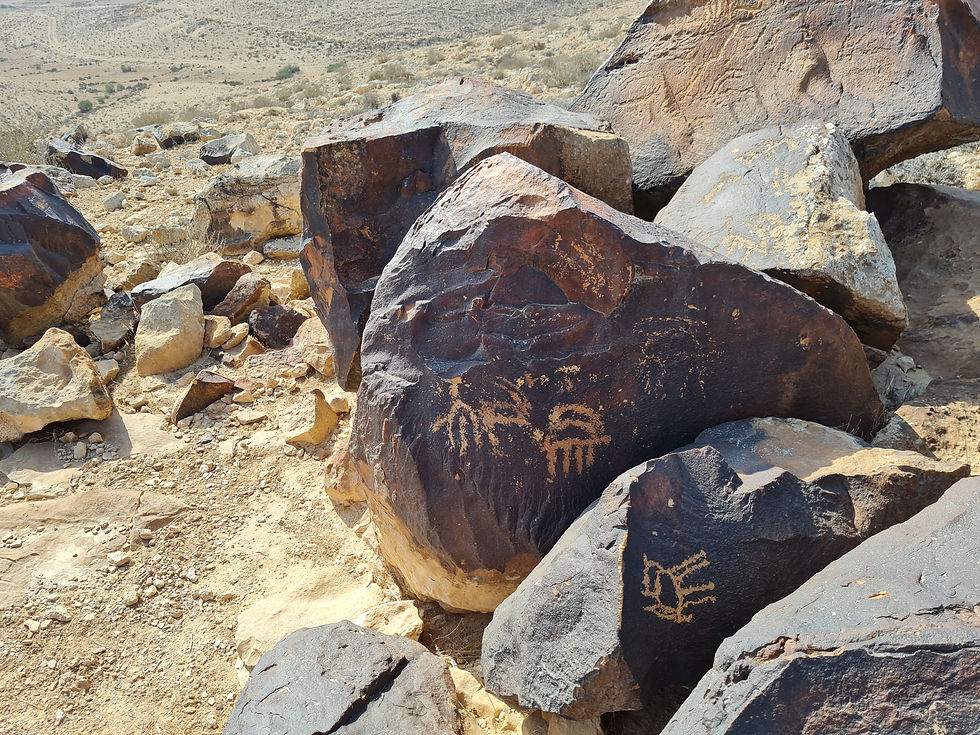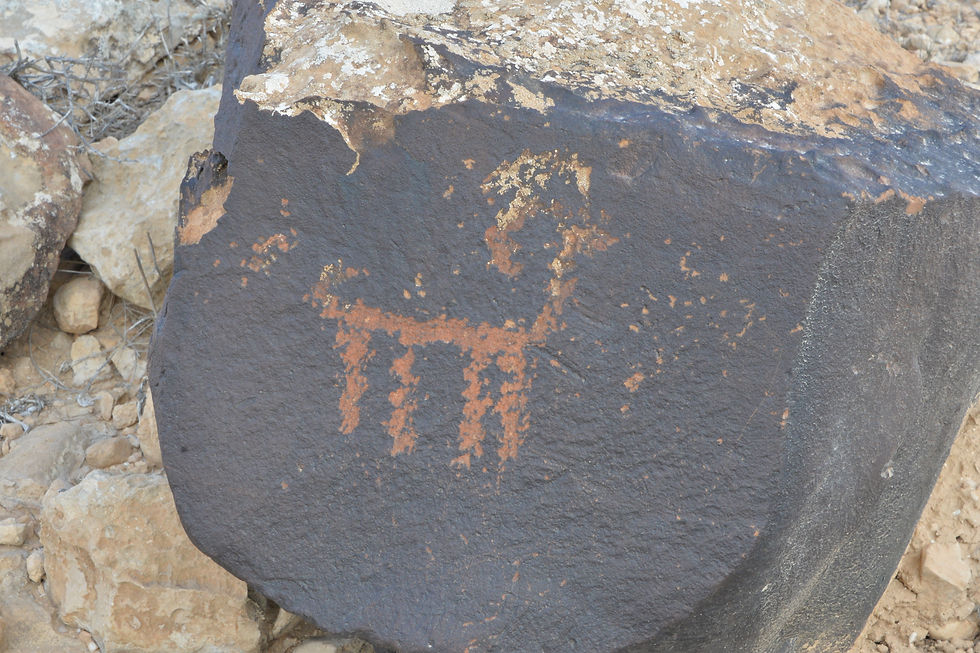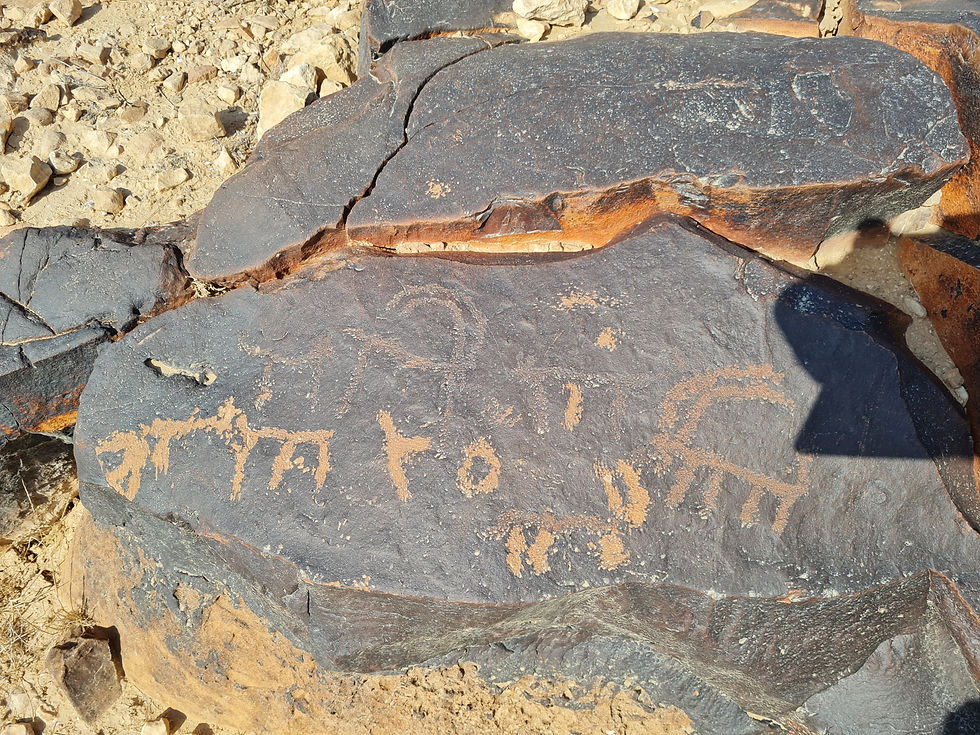Mount Arkov is located 660 meter above sea level opposite the ancient Nabatean town Avdat.

Avdat was founded in the 3rd century BC and for about a thousand years it was an important stop for the caravans of the Incense Route between Petra in Jordan and the ports of the Mediterranean Sea.

When Avdat was founded the rock art of Mount Arkov had already existed for thousands of years; the oldest rock art is estimated to have been created about 5000-6000 years ago. Interestingly Strabo, the Roman geographer (63BC-ca 25AD), who traveled from Alexandria to Petra, and probably crossed the Negev, he did not describe the Negev rock art; nor did anyone else until the 1954 survey of Mount Karkom undertaken by Anati.

We walked from the gas station along wadi Avdat with the Ramlia water cisterns; they were dry but may fill after rain. I walked 21,702 steps that day!

Arriving at the top we saw some tumuli, or piles of grey rocks, these are old graves, but younger than the oldest rock art on the mountain.


At the top of the mountain, we see boulders of dark brownish color, almost black with lighter figures. The dark color is patina or rock varnish that covers the underlying light limestone with a few mm thick membrane. It is not known what initiates the process of making the patina.
This membrane consists of micro-organisms (actinobacteria (33%), strains of cyanobacteria (30%), proteobacteria (15%), Bacteroidetes (7%)) building a microbiome that entraps a thin layer of Mn and Fe oxides embedded in clay; this is influenced by extreme heat during the summer months and colder weather in the winter and further weathered by wind, rain and sandstorms.

These processes continue all the time even today gradually giving the light images a darker color. Therefore, the older the image, the darker it becomes; the lighter the image the younger it is. It is very problematic to date the rock art, it is possible to give a relative chronology by how light or dark the image is; the darker the older. Often the arts carved pictures on older pictures or next to older ones.

Another thing that can help give a relative date, is what animal is in the picture.

The ibex is very prominent in the rock art and has also been identified in archeological findings of bones for the period 14,000-9,500 BC, but then became scarce indicating perhaps transition from hunter-gather culture to herding with goats which to some extent is ongoing by present day Bedouins, but not present in the images.

The camel was introduced to the area 1300-1000 BC and there after seen in the rock art. Camels are very useful for transportation of bigger loads than horses and donkeys can manage and they do not need to drink water every day. Camels have milk that is very healthy according to the Bedouin folklore.


For past two hundred years and until today the Bedouin tribes scratch their tribal or family signs on the rocks (wasm) as territorial borders; these are abstract signs and clearly visible being light.

In ‘The Little Prince’ the pilot was encouraged at of six years to give up a magnificent career as a painter; so, when he met the Little Prince, he did not know how to draw a sheep and put it in a box. I believe it is more difficult carve in the rock than to draw, I am sure I could not do it. My question is where did they learn to do their craft? The images are clear and various animals are recognizable.

Through out Central Negev more than 200,000 rock art engravings have been identified.

Petroglyphs is a more neutral word; the Hebrew ‘rock scratching’ hurts my ears and hearing. In the encyclopedia petroglyphs is defined as a prehistoric art form of stone age cultures, as a forerunner to a written language.

Rock art is found all over the world. History is defined as records of what was; maybe rock art is a historic record of what was and maybe one day, we will discover a petroglyph ‘Rosetta Stone’ which will allow us to decipher it the way we did with the hieroglyphs two hundred years ago.

I call it rock art, because I think it is an expression of art from ancient artists who lived here before me and also appreciated the Negev as do I. A historic treasure.


View of the area from the top of Mount Arkov.
Comments